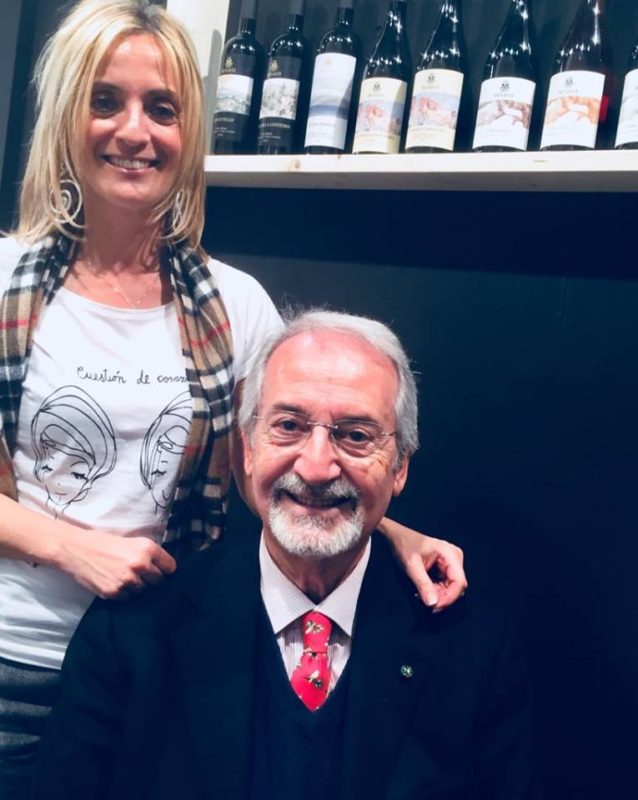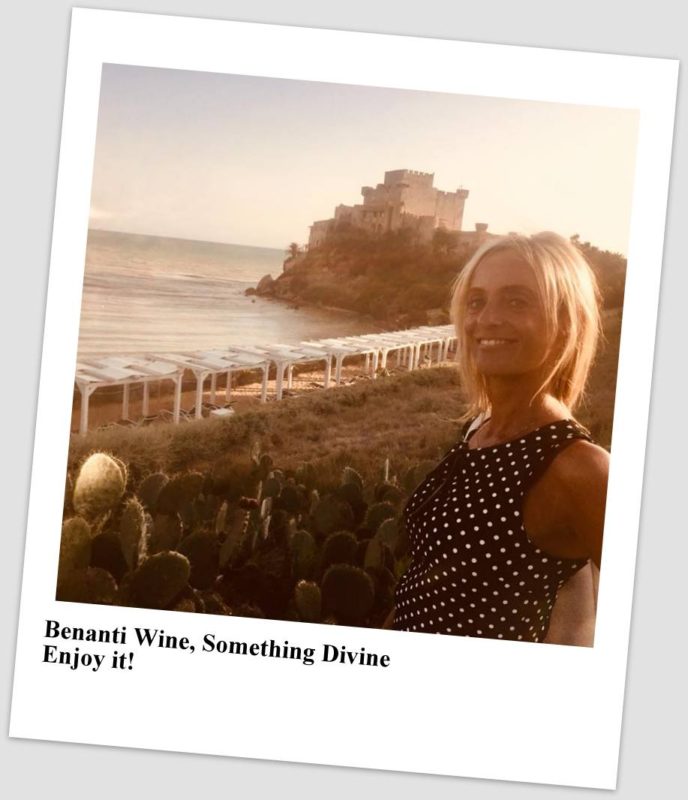“Non invidio il paradiso, perché sono soddisfatto di vivere in Sicilia”
“Cantina Benanti”, Etna: la Sicilia che vorrei
Curiosa come tutti i Sommelier, penso che il vino sia un modo per guardare posti già battutti con occhi diversi. Il mio viaggio nei vini dell’Etna mi ha dato la possibilità di esplorare meglio lo straordinario patrimonio vitivinicolo della Sicilia , l’isola in cui sono nata. Seguitemi in questo racconto che parla di un Sud che vale!
Per questa scoperta devo ringraziare i miei colleghi toscani del gruppo “AIS di Lucca” . Sono loro i responsabili , che mi ha fatto innamorare della “Cantina Benanti” con la degustazione di 2 dei lori vini:
- “Rovittello Etna Rosso DOC 2011” : un rosso fatto di Nerello Mascalese e Nerello Cappuccio , vitigni autoctoni dell’Etna. Un vino vivace, dal colore rosso rubino carico, dai profumi di more. Inoltre esso è molto speziato, fresco, perfettamente equilibrato, e si presta a invecchiamento;
- “Pietra Marina Bianco Superiore 2011” : un bianco fatto di 100% di Carricante, anch’esso vitigno autoctono dell’Etna. Esso è prodotto da vigne selezionate di Milo in “Contrada Rinazzo’“. Si tratta di un raro esempio di vino bianco da invecchiamento . Il suo giallo paglierino è intenso. Odora di mela, mandarino, fichi d’india, fiori di zagara, pietra focaia e lava vulcanica. La sua mineralità è suadente così come la sua struttura , e il suo finale persistente.

“Cantina Benanti” , primo incontro al “Vinitaly 2018 “
Il sogno di conoscere meglio la “Cantina Benanti” si è realizzato a Verona, in occasione del “Vinitaly 2018″ , celebre manifestazione dedicata al mondo del vino.
Giuseppe Benanti e i figli Antonio e Salvino , sono i titolari della “Cantina Benanti” . Una realtà che in questi trent’anni è stata un vero e proprio traino per la Trinacria, al punto da scatenare un vero e proprio “miracolo etneo” .
L’ uggiosa domenica di Aprile al “Vinitaly 2018″ si è scaldata con la famiglia Benanti, appena mi hanno parlato della loro storia, del loro legame profondo con la terra, con la gente e la Sicilia.
I vitigni autoctoni dell’Etna
E ancora una volta la Sicilia mi è venuta in mente in tutto il suo splendore attraverso la degustazione delle migliori etichette della “Cantina Benanti , provenienti da sole uve tipiche dell’Etna. Tra le quali:
- Nerello Mascalese: questo è il principe dei vitigni rossi autoctoni dell’Etna, Portato originariamente dai greci, questo vitigno arriva a maturazione nella terza decade di ottobre. Esso si presta a lunghe macerazioni, ed esprime il suo meglio quando il vino viene affinato per molti anni. Il vino che ne origina è fine ed elegante, scarico di colore, sapido e con tannini setosi;
- Nerello Cappuccio (detto anche Mantellato) : anch’esso un rosso autoctono di prestigio dell’Etna. Il suo nome è dovuto alla particolare conformazione della pianta, coltivata ad alberello. La sua origine non è nota , ma viene coltivato in loco da diverse centinaia di anni. La sua produzione è andata calando anno dopo anno . Per un certo periodo se ne è temuta pure l’estinzione. Esso viene raccolto molto tardi, verso la metà del mese di ottobre. Il vino rosso che se ne ricava è fine, leggiadro ma al tempo stesso deciso;
- Carricante : anche questo è vitigno autoctono a bacca bianca dell’Etna , ed è un tesoro immenso. Anch’esso tardivo nella maturazione, dà al vino un colore giallo paglierino e delle note minerali molto spiccate. Sorprendentemente per un vino bianco esso si presta ad invecchiamenti anche superiori ai dieci anni, caratteristica che lo pone idealmente prossimo ai Riesling alsaziani
Ecco la mia top list dei vini della “Cantina Benanti”
- “Noblesse”: uno spumante “Metodo Classico Brut”, fatto di Carricante in purezza. Le sue bollicine sono fini e di grandissima piacevolezza;
- “Etna Bianco Benanti“ : anche questo è un bianco di Carricante al 100%. Che dire, è un vino tanto minerale, intenso, ricco e fruttato. Possiede una piacevole acidità e un lunghissimo finale in bocca;
- “Etna Rosato Benanti“ : uno dei rosè più raffinati che abbia mai assaggiato, fatto di 100% Nerello Mascalese ;
- “Etna Rosso Benanti”: questo è un blend di Nerello Mascalese e Nerello Cappuccio . Vi assicuro che è un vino rosso di una eleganza e freschezza estrema;
- “Nerello Cappuccio Terre Siciliane, IGT Rosso”: questo è prevalentemente fatto da Nerello Cappuccio , che regala un rosso secco, acido, poco tannico e armonico;
- “Serra della Contessa, Etna Rosso DOC”: questo rosso è fatto da 85-90% Nerello Mascalese più 10-15% di Nerello Cappuccio. Una bomba esplosiva di profumi e sentori di more e spezie.
“Cantina Benanti”, la rinascita dei vini dell’Etna
La “Cantina Benanti” è stata protagonista della “rinascita dei vini dell’Etna”. Giuseppe, Antonio e Salvino hanno lavorato per primi e con amore i frutti generosi del territorio Etneo. Lo hanno ridisegnato e potenziato con ingegno e perfezione, davvero un esempio lodevole di “viticultura eroica” alle pendici dell’Etna.
Il successo dei dei vini dell’Etna è dovuto anche a un terroir unico nel suo genere :
- Microclima mediterraneo e di montagna (Catania è, infatti, alla stessa latitudine della punta settentrionale della Tunisia, e la vite sull’ Etna arriva fino ai 1300 m di quota);
- Grandi escursioni termiche;
- Suoli vulcanici ricchi ed eterogenei per composizione ( con la presenza di cenere e lapilli);
- Diversa altitudine ed esposizione solare;
- Età avanzata dei vigneti (spesso pre-fillosserici).
Intervista a Giuseppe Benanti. Castello di Falconara
Sicuramente il “Vinitaly 2018″ è stato un primo approccio importante per avvicinarmi alla “Cantina Benanti” . Al rientro nell’isola per le mie vacanze estive, ne ho approfittato per fissare un’intervista con Giuseppe Benanti, il fondatore nel 1988 della storica impresa vinicola .
L’incontro è avvenuto presso il favoloso “Falconara Resort” (Butera) . Ci siamo ritrovati a fare due chiacchiere come tra buoni amici sotto un pergolato di palme e ulivi , che ci hanno riparato dall’afa di un sabato d’Agosto. Location perfetta per accogliere una personalità di spicco come Giuseppe Benanti .
Tra un aperitivo e l’altro , davanti lo spettacolo di un mare africano , e di un orizzonte infinito , il cavaliere si presenta con tutta la semplicità e la classe che contraddistingue la sua prorompente personalità.

La storia del Cavaliere Giuseppe Benanti
Giuseppe Benanti è un imprenditore catanese nel campo della farmaceutica da generazioni. Giusto per essere precisi il cavaliere è stato promotore della “Sifi” , la società catanese del settore oftalmico . Questa è terza in Italia per quote di mercato, dietro due multinazionali !
Giuseppe Benanti è un uomo di altri tempi , che ha una grinta e una voglia di vivere da fare invidia a un ventenne! Ha avuto varie nomine per il suo grande genio, tra queste quella di “Cavaliere del Lavoro“, ed “Accademico Aggregato dei Georgofili“.
Giuseppe Benanti ha fatto di un’ antica passione di famiglia per il vino un punto di riferimento ed un fiore all’occhiello per l’intera economia del territorio Etneo e Siciliano.
Come è iniziata l’avventura di Giuseppe Benanti nel vino?
Tutto iniziò quasi per caso a fine anni’ 80 al “Picciolo Golf Club” di Castiglone di Sicilia. Giuseppe Benanti era per caso a pranzo con Francesco Micale, suo caro amico medico . Rimanendo insoddisfatto di un rosso ordinato al tavolo, scommise che si poteva e si doveva fare di meglio in fatto di vini a Catania. Perché l ‘Etna era un luogo ricco di grandi potenzialità.
Giuseppe Benanti, uomo di mondo, sofisticato, ma anche profondamente legato alla Sicilia, tornando in patria, non si accontentò certo di bere vino mediocre! Cominciò così a cercare quel qualcosa in più nel vino che altri non furono in grado di scovare
Un visionario dall’ animo inquieto, che nel giro di pochi anni realizzò il “rinascimento” dei vini Etnei. a dispetto del più modaiolo Nero d’Avola di quel periodo.
Francia e Piemonte come modello per dei vini Etnei nuovi e di tendenza
Giuseppe Benanti comprese velocemente il tremendo potenziale non sfruttato sulla “muntagna” , e si circondò di uno staff di autorevoli personalità dell’ enologia provenienti dalle Langhe e dalla Borgogna. Tra questi :
- Salvo Foti, punto di riferimento per il movimento del vino sull’Etna;
- Rocco di Stefano dell’ “Istituto di Enologia” di Asti
- Jean Siegrist, professore di enologia all’ Università di Beaune.
Giuseppe Benanti fu un pioniere in fatto di vino, perché intravide una punta di diamante laddove gli altri fermarono lo sguardo su uno strato di carbone.
Valorizzazione dei vitigni autoctoni dell’Etna
Giuseppe Benanti ebbe un’intuizione importante che poi diventò una filosofia aziendale:
- impiantare i vitigni autoctoni dell’ Etna su più versanti e contrade del vulcano , ognuno con differenze ampelografiche e di terroir notevoli e oggettive, per offrire varietà ed eccellenza.
Il cavaliere capì che bisognava puntare a Nord dell’Etna per i rossi autoctoni, quali il Nerello Cappuccio, e il Nerello Mascalese. Per i bianchi autoctoni, quali il Carricante, Giuseppe Benanti puntò invece più a Sud dell’Etna, precisamente nel comune di Milo .
Per cui il primo polo dellla cantina nasce nel 1988, a Castiglione di Sicilia con l’originario nome di “Tenuta di Castiglione”.
Giuseppe Benanti , un visionario del vino
Dopo nel 1994 Giuseppe Benanti lavorò per conto di terzi l’area vitivinicola a Santa Maria di Licodia (Etna sudovest). Poi finì per allagarsi fino a Monte Serra a Viagrande (Etna sud est), zona del nonno, riprendendo con ben altra visione l’attività amatoriale di famiglia avviata qui alla fine del 1800.
Giuseppe Benanti investì tutto e subito con decisione su tali varietà. Effettuò circa 150 prove di micro vinificazione. Inoltre valorizzò sia i tradizionali assemblaggi tipici della “DOC Etna Rosso” (Nerello Mascalese più Nerello Cappuccio) , che i mono vitigni , che all’ epoca erano una vera rarità.

Famiglia Benanti, carattere Etneo dal 1734
Nel giro di pochi anni la “Cantina Benanti” ispirò diversi produttori giunti in seguito sull’ Etna e diventò in breve tempo un distretto vinicolo di eccellenza.
Dal 2000 a oggi la “Cantina Benanti” contribuì ad incrementare ancor di più la visibilità e la conoscenza dei vitigni autoctoni etnei, e si evolse attraverso importanti tappe aziendali.
Tra queste:
- 2003 primo spumante metodo classico dell’Etna da uve Carricante;
- 2010 selezione ed ottenimento del brevetto di quattro lieviti autoctoni, ancora oggi, esempio unico sull’ ’Etna.
Cambio generazionale: Antonio e Salvino Benanti
Nel 2012 si affiancarono a Giuseppe Benanti i figli Antonio e Salvino. Classe 1974, i brillanti gemelli erano reduci da esperienze accademiche e lavorative di diversi anni all’estero e poi in Italia.
Antonio e Salvino interpretarono con ancora maggiore focalizzazione e rigore il modus operandi dell’azienda . Agirono da subito con grande decisione facendo scelte importanti.

“Cantina Benanti”, un modello da seguire per una Sicilia migliore!
Si era fatto tardi al “Falconara Resort” . Giuseppe Benanti e io ci avviammo a cena alla “Bottega”, un rinomato ristorante del lussuoso “Relais Villa Giuliana” (Agrigento)
Un piatto gigantesco di crostacei freschi serviti su ghiaccio e una bottiglia di “Seleziona di Familia di Cantine Milazzo” fu l’unica cosa capace di far scendere improvvisamente il silenzio tra me e il cavaliere.
In conclusione , Giuseppe Benanti è un motivo in più per essere fiera delle mie origini siciliane. La sua carriera professionale , e il suo modo di pensare vanno oltre il provincialismo italiano, motivo per cui ha creato un impero che corre come al presente come un treno!

Scheda e info utili della “Cantina Benanti”
- Sede: a Viagrande (Ct), Contrada Monte Serra, Via G. Garibaldi, 361;
- Tel: 095 7890928 – Cell. 392 9834099;
- Mail: benanti@vinicolabenanti.it ;
- Sito web: www.vinibenanti.it;
- Enologo: Vincenzo Calì;
- Ettari vitati: 24;
- Bottiglie prodotte: 170.000;
- Vitigni: Nerello Mascalese e Cappuccio e Carricante.
If you like my post, please subscribe to the socials of www.WeLoveitaly.eu :







